Eastward – – a little
A cold, drenching rain splatted on our jacket hoods and backpacks. We own only the most modest of rain gear, and the persistent droplets gradually found their way past weak defenses into zipper pockets and unprotected pants legs. After only a few hours walking/hiking, we were ready to head back to Howie’s warmth and comfort. Oh, but wait – Howie was a three-hour drive away, back up the potholed, wash-boarded, mud-slide-intruded McCarthy Road that we came in on.
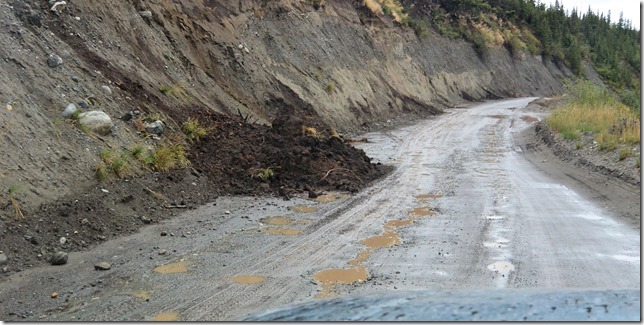
We had ventured down this access road (one of two) earlier in the day, to see and explore the old mining community of Kennicott, deep in the huge expanse of Wrangell St. Elias National Park.
Outside the Park, our campground was positively tiny, the smallest we’ve ever stayed at. With only four RV sites, and a handful of tent sites, it was downright cozy. A miniscule 200-yard-long access road loops the camp completely; the miniscule array is further bisected by a gorgeous mountain stream, Liberty Creek, and its falls. And it’s all overgrown and intertwined with the surrounding forest — already beginning to show yellow dropping leaves in mid-August.
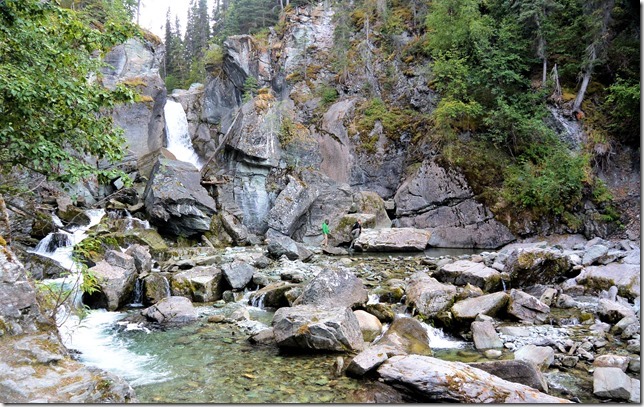
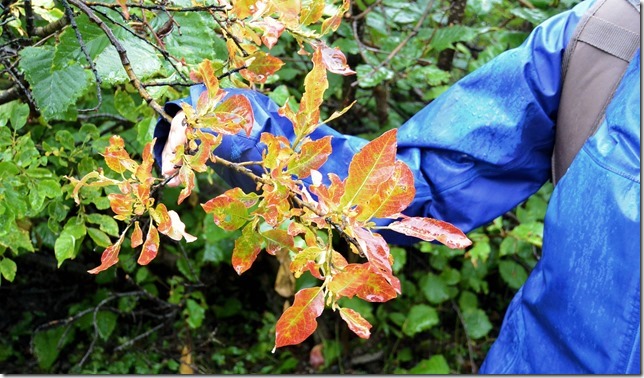
Back on the Kenai Peninsula, we saw and did some amazing things during our time there. Our glacier-kayaking trip is still the highlight of our journey in the North (see that post HERE). But it was inarguably a crowded place. After spending the last few weeks shoulder-to-shoulder and ear-to-generator in crammed public campgrounds full of salmon fishermen and noisy party-goers, we found ourselves deeply grateful for the relative peace.
When we first arrived at our camp, the rain had not started in earnest. The few rain-drops tap-tapping on Howie’s roof were nicely accompanied by a sigh of the wind in the tree-tops. Pervading it all in a grand surround-sound was the rush of the Creek, only thirty yards away from our camp site. There was no electricity, no Internet, no water – just us and Howie and Ralph. Pure bliss.
Camp was only thirty or so miles off the Richardson Highway, and we had interrupted our travel to Valdez to investigate the giant Park. McCarthy Road turns from so-so pavement at camp to egad-dirt a few miles east. So our next step would be to leave Howie in camp and take Ralph down the grungy road for further explorations.
Wrangell St. Elias (I’ll call it WSE) is the largest national park in all of the United States, five times bigger than Yellowstone and twice the size of the huge Denali. It measures 13.5 million acres – over 21,000 square miles. More than the sum of the states of New Hampshire and Vermont. What’s more, it is immediately adjoined by the Kluane National Park of Canada, which is in turn adjoined by Tatsenshini-Alsek Provincial Park, which is in turn adjoined by Glacier Bay National Park. The extended combination has created a contiguous protected area of nearly 25 million acres, 40,000 square miles, of wild landscape. Map is from the wiki.
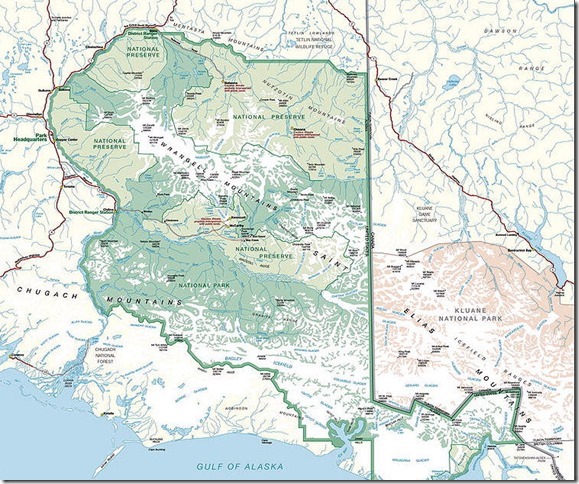
Into the immensity of the northern wilderness section probe two tiny little access roads, the McCarthy Road in the south, and the Nabesna Road in the north. The only other access to the deep interior of WSE is generally by foot. However, the distances are so enormous that special allowances have been made for vehicular travel (normally prohibited in wilderness areas). Aircraft, snowmobiles, and ATV’s all have special privileges. The 1980 Alaska National Interest Lands Conservation Act (ANICLA) established a cooperative relationship between humans and wilderness areas, somewhat more “permissive” than the stricter standards in other National wilderness areas. More at the wiki HERE if you are interested. This new framework, designed to allow subsistence hunting and fishing, also allows improved access, which is especially important when the wilderness is a hundred times larger than anything previously conceived or designated.
The most easily-accessed feature in this, the southern-road section, is the old mining town of Kennicott. Like most of the roads in the North, present-day roads in the Park were built from miners’ trails. However, in this case it was copper instead of gold that paved the way. The extraordinary discovery of high-grade ore (up to 85% copper, unheard of even today) got J. P. Morgan’s attention. A few years and tens of millions of dollars of investment later, the Kennicott mine went into production. It would earn more than a billion dollars in today’s money over it’s 35-year operational span. And so we trekked (with Ralph) the 60 or so miles from camp, deep into the Park to the old mining town. Some was paved, some was good dirt, and some was suspension bump-stop ugly. The last stretch was by foot and shuttle, due to the mixed land-ownership in the Park.
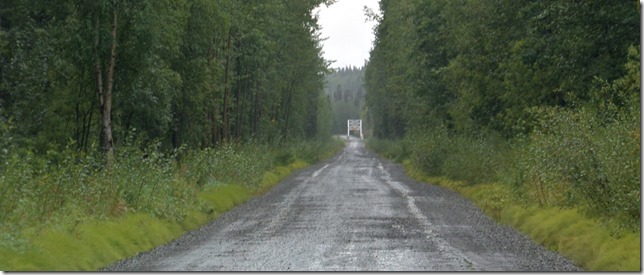
We sneaked a peek over the guardrail of the long one-lane bridge. (No, no signal lights or flag-persons. Just a watchful eye and courtesy.) The river is 238 feet below our tires, and we are in the middle of the 500-foot-long bridge.
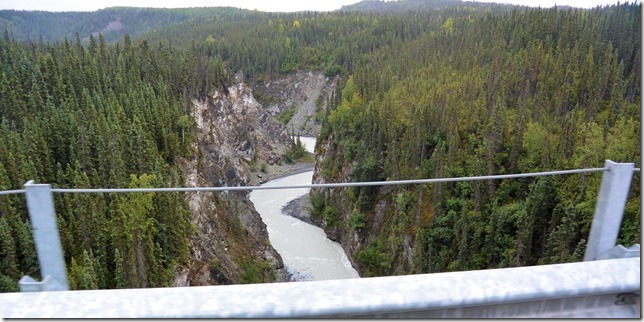
We missed a lot of scenery in the clouds, but it was still an engaging trip. Arriving in town, we found it utterly fascinating, and awe-inspiring, to learn about how folks of “yesterday” lived, and made their living, in this harsh wilderness. Even the building of the railroad to support the mine is a tale in itself. (And guess what, today that railroad is McCarthy Road – it was converted from the old railway bed.)
The heart of the old town was the copper mill, an extraordinary affair that spanned several blocks and almost 20 vertical stories. Shipping was punishingly expensive from this remote mine, so the copper had to be as refined as possible before leaving. The mines, and the mills, ran year-round. Apparently the mill work was considered a “benny” job, because it was guaranteed warm winter work.
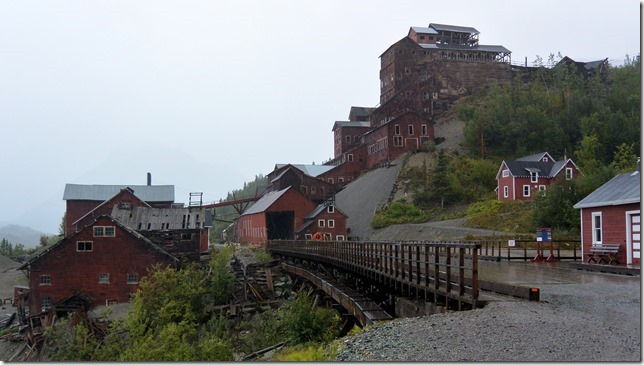
Many of the buildings have been re-built (but by no means all of them). Some are under-way. It’s a fantastic window into the era, and the minds and hearts of the people who made it happen.
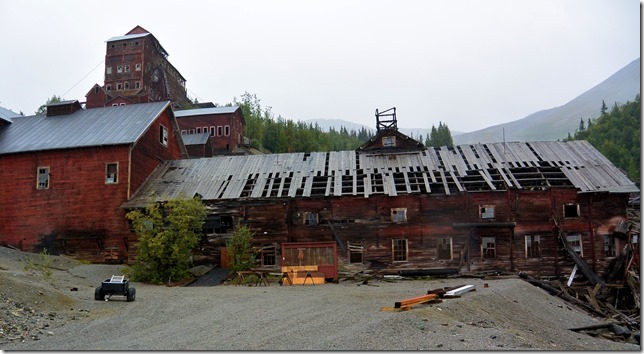
Much of the mill’s interior is still intact (not operational of course). You just can’t help admiring the folks who put this all together – eco-sins notwithstanding.
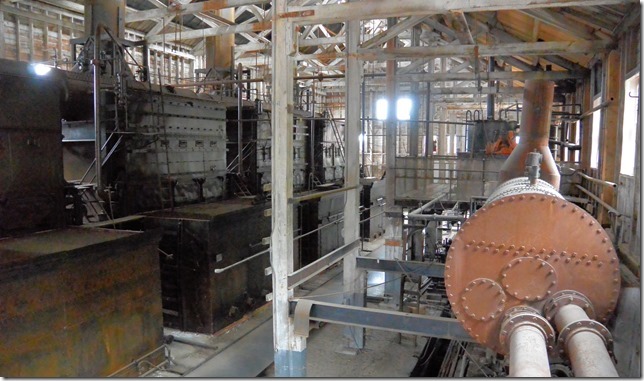
As one of thousands of examples of 19th and 20th century land “custodianship”, the Kennicott miners took all their dud blasting ordinance and simply tossed it out behind the mill. Today, it’s a prohibited area. Likewise with the town’s trash, shadowed by miles of cast-off mine tailings. Out of sight, out of mind.. Not all the old townships are 100% charming, we have found over and over again.
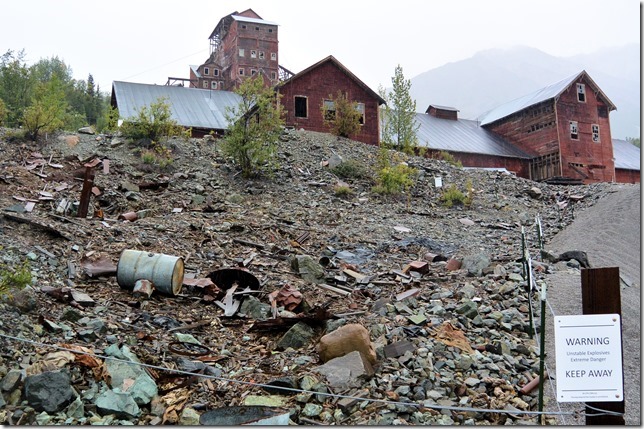
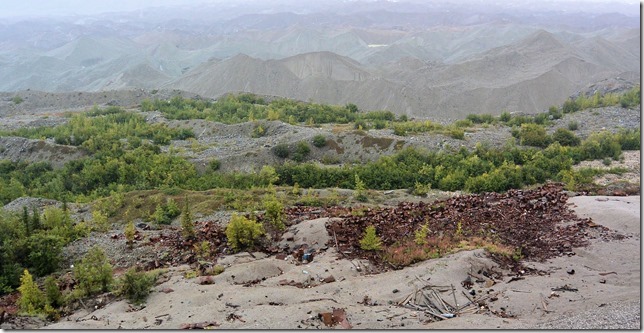
Although the byway is primarily a route to Kennicott, McCarthy Road passes a variety of other features along those 60 miles. The rain and weather were completely shrouding some of the area’s grandest attractions, 16,000-foot peaks, glaciers and alpine scenery. We’re hoping for a better view when we re-visit the Park in the northern section. In the meantime, we still found some sights to share.
The huge, braided Copper River has an area that’s extremely popular with the (subsistence) fishing crowd, and fish-wheels can be found lined up along the most productive banks.
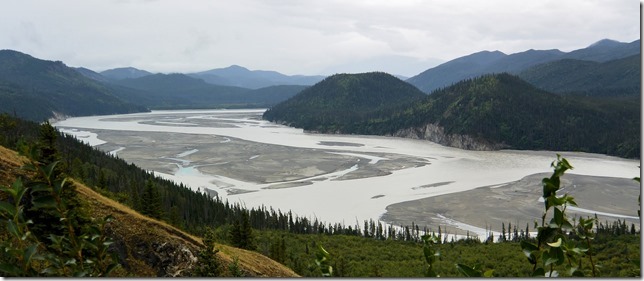
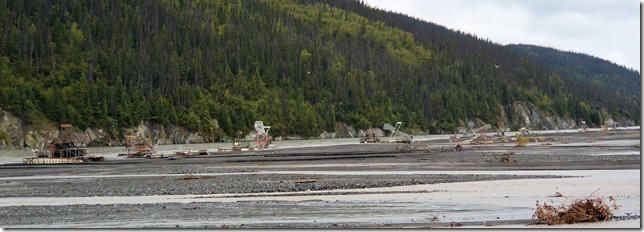
The river obviously floods and wanes – one sorry soul left his motorhome out on the rain a bit too long one year. It’s still there, sinking deeper into the river with each season.
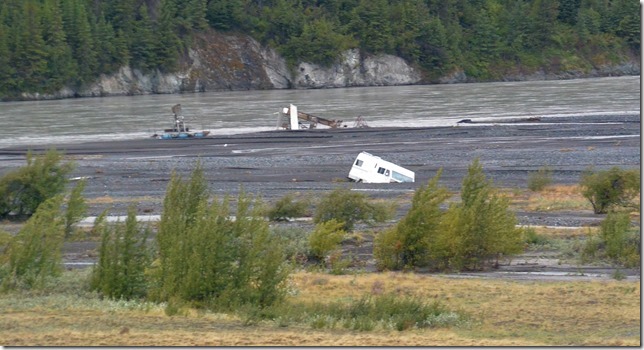
Many, many small lakes and streams line or cross the road, and wildlife can be found here and there. A family of swans watched us go by a small pond. Later, a cow moose studiously ignored us as she munched on roadside grasses.
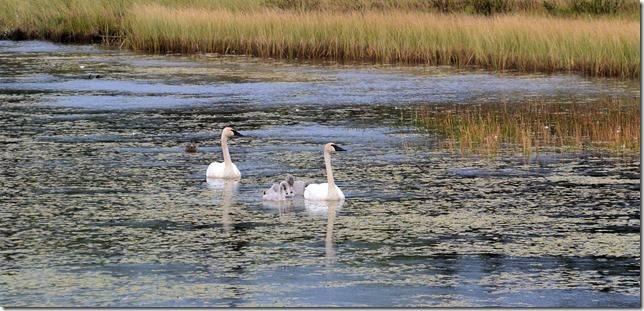
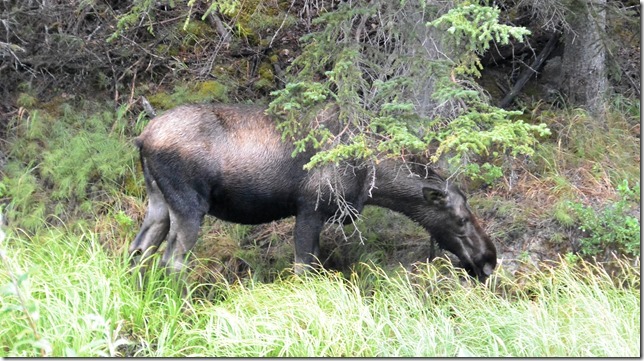
Sometimes the road departs from the original rail grade. Here’s an example, where the original trestle is still intact (although not serviceable or safe). Remember, these things were hand-built in the early 1900’s, with saws and hammers, in –50F weather. Simply amazing.
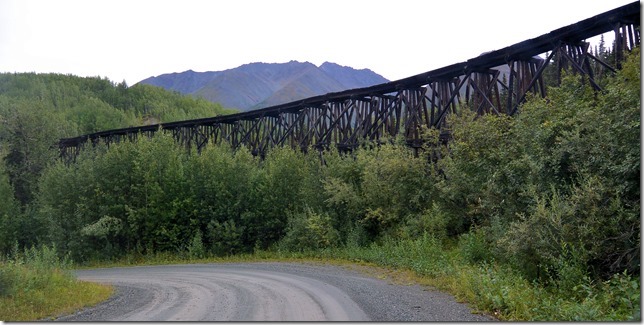
After thinking about the hardships and pain that the early folks went through, we felt slightly better about our soggy selves as we worked our way back to camp. The rain was coming down in earnest, puddles and lakes everywhere on the road, and around camp. Inside Howie, it sounded like someone was playing a fire-hose nozzle on the roof. Our moods brightened further as we warmed up Howie’s interior with the catalytic heater, cooked a hot meal, and settled in for a cozy evening. Life is good.
Tomorrow, on to Valdez.

What a trip! Thanks for making it interesting with the great writing.Love all the pics as they seem to tell a story themselves.Be Safe,—John L.
Thanks again, Greg & Karen, for sharing this great journey, and having us relive our time in Alaska, through different eyes. Wonderful. Does make us want to re-visit – with better heating than our truck had!!
Yeah, Life is GOOD!
Thanks for the post Greg.
News today of mudslides down the coast in Sitka due to the heavy rain. Hopefully, you guys were spared in Valdez. Also, the daily photo on Bing today is an aerial view of a glacier in Wrangell-St. Elias National Park. Thanks for the great tour of Kennicott.
Wow ! What a fantastic trip!
Great job on wordsmithing!
Best wishes,
Robert